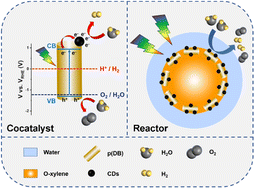Bifunctional carbon dots as cocatalyst and reactor decorating an organic photocatalyst for H2 production from water-splitting in an emulsion†
Abstract
Generation of clean hydrogen (H2) energy by photocatalytic water-splitting is a prospective method for solving the global energy crisis and environmental pollution and the design of new generation catalysts is expected to combine the functions of catalysis and reactor. Here, we illustrate the synthesis of organic polymer photocatalyst p(DB) synthesized from 5,11-dihydroindolo[3,2-b]carbazole and 1,2-bis(4-bromophenyl)ethane. The carbon dots (CDs) are utilized to modify p(DB) and the optimal sample 5% CDs/p(DB) exhibits highly efficient H2 production under visible light in an o-xylene-in-water emulsion, whose average rate of H2 evolution reaches 140.88 μmol g−1 h−1. Furthermore, the transient photovoltage (TPV) and photoelectrochemical measurements suggest that the CDs improve the charge transfer process and the charge extraction ability of p(DB). Moreover, the CDs play the role of an emulsifying agent as well as providing chemical reaction sites for photocatalytic water-splitting. This work provides a deep understanding of the functions of CDs to integrate a cocatalyst and reactor.



 Please wait while we load your content...
Please wait while we load your content...